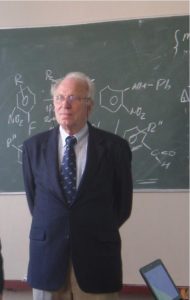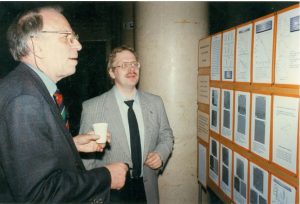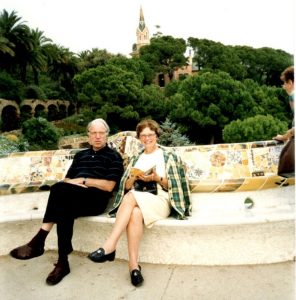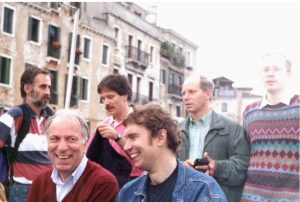Prof. Andrey Kaul
Department of Chemistry, Lomonosov Moscow State University,
Leninskie gory 1-3, 119991, Moscow, Russia
arkaul@mail.ru
It happent that in a person’s life there are events that have a decisive influence on the whole subsequent life path. The astonishing discovery of high-temperature superconductivity in 1986 made me, together with my research team at the Chemistry Department of Moscow State University, stop many years-research in the field of solid-state ionics and ceramic solid electrolytes and switch to the chemistry of HT superconductors, in particular, to the development of chemical methods for obtaining thin HTSC films. Our efforts in particular were aimed at developing the metal-organic chemical vapor deposition with use of volatile precursors of beta-diketonate class. By that time, we were well acquainted with the chemistry of these substances, including their synthesis, the characteristics of their volatility, and thermal behavior. However, in the design of reactors, the issues of gas-dynamics, heat and mass transfer, and how these factors affect the elemental composition of multicomponent films, their stoichiometry, and morphology, we were neophytes and the initial progress was difficult. I was looking for contacts with a scientific group more experienced in these matters than our group at that time. We were aware of the works by Georg Wahl and his colleagues on the deposition of Nb3Ge and NbC1-yNy superconductors that appeared in the late 1980s. Those were outstanding works demonstrating profound understanding and many-sided studies of CVD processes. A bit later on there appeared a series of works by Georg together with Franz Schmaderer on MOCVD of new HT superconductors where they managed to create YBaCuO layers whose qualities were the best at that time.
It September 1990 I had the pleasure of meeting Georg at the Third Soviet-German Bilateral Conference on HT Superconductivity in Karlsruhe. At that time he was heading a group of researchers at the ASEA (ABB) Company in Mannheim. In the very first conversation I felt that I was talking with an exceptionally open-hearted and open-minded person open to scientific contacts. I asked Georg if it was possible to visit his laboratory, and the very next day we, I and the head of the Department of Inorganic Chemistry at Moscow University, Academician Yu.D. Tretyakov, were able to get acquainted with their work and CVD equipment at the ABB laboratory. Georg showed interest in my suggestion to send one of my young colleagues for an internship at his laboratory, but he thought that it would be easier to arrange it when he got the position of professor and director of the Institute of Surface Technology and Plasma Development of Materials (IOPW) in Braunschweig Technical University.
He did not forget his promise and about a year later I got a letter from him inviting us to cooperate with him. By that time he had got the position in Braunschweig and started to equip his lab in IOPW. Soon our laboratories worked in close contact due to the fact that emerging scientists of MSU were able to get scholarships from DAAD, sometimes from the Russian Government, and could spend long periods of time (up to a year) at IOPW under Georg’s guidance, which greatly stimulated their scientific development and personal growth.
In addition to this form of cooperation both our laboratories worked together on European projects (INTAS) and in projects sponsored by German Funds BMBF, DFG and Volkswagen. Initially, these projects concerned MOCVD of HTSC thin films, and later of a number of other thin film functional materials, such as ferroelectrics, conducting oxides, materials with giant magnetic resistance, epitaxial capacitor heterostructures, perovskite membranes with selective oxygen permeability, etc.
Describing Georg’s personal work style, I would like to outline two features. Working in the experimental field, he always sought to highlight the theoretical basis of the experimental work, and wherever possible, always preferred to use the mathematical language, which he knew very well, and thereby introduced more rigor in the work on CVD. On the other hand, all the projects carried out under his guidance were always very practical. They concerned the development of new materials or their technologies for solving specific large-scale technical problems, such as the creation of thermal barrier coatings on the blades of aircraft turbines, thin barrier films of BN on the reinforcing SiC-fibers of composites with a steel matrix, the deposition of superconductors on carbon filaments etc. Georg knew very well modern engineering and technologies and was interested in them no less than in the science itself.

The last important topic we cooperated on was the MOCVD technology of second-generation superconducting tapes, which included the processes for buffer layers and superconducting layer deposition onto metal tapes in reel-to-reel mode. In the long run this technology made the basis for two startups – SuperOx in Moscow and PerCoTech (guided by Dr. Oliver Stadel) in Braunschweig. These two companies continued their close and mutually beneficial cooperation even when Georg retired.
The two laboratories really complemented each other: the Wahl laboratory was stronger in the numerical simulation of gas dynamics and thermochemistry of CVD processes, and in the construction of reliable large-scale CVD devices, while the Moscow laboratory had more experience in the chemistry of volatile precursors and multicomponent oxide systems. Those were prolific years: we published nearly 40 joint articles and made a considerable number of presentations at various conferences. Our cooperation brought us both great satisfaction and joy, mostly due to the trusting and friendly relations among PhD students of our respective laboratories which provided the framework for of it all; to a great extent it was our, Georg’s and my own, personal friendship that stimulated and inspired and was at the core of it.
Georg was an exceptionally well-wishing and open-hearted man who could not but ignite similar responses in those who knew him. His characteristic feature was his most sincere interest in his interlocution, intertwined with careful delicacy. He used to be a frequent guest of the inorganic department at MSU, always cordially welcomed by the colleagues, old and new. Georg participated at all the International Workshops on High-Temperature Superconductors and Novel Inorganic Materials Engineering conferences organized at MSU in 1989-2004 and in three-trilateral German-Russian-Ukranian workshops on HT Superconductivity. Also he would come to the All-Russian Conferences on Surface Chemistry. I was often surprised seeing him deeply engrossed in a discussion over a PhD student’s poster presentation, penetrating into the heart of the matter, often resorting to the Russian language. Georg learnt Russian on his own and went on doing it even during his last years. His knowledge of Russian was sufficient for him to read classical Russian literature. Particularly, he would often read Chekhov. Each time when he was in Moscow he would buy a load of Russian classics, and he also tried to speak Russian when he was in Moscow.

Georg was a positively thinking man with a remarkable sense of humor. Once being in Moscow, he was my guest. I read to him some pages of Saltykov-Shchedrin, my favorite Russian satirist, where there was an allegorical scene of a conversation between two boys. One being “a boy in pants” the other “a boy with no pants on”, symbolizing German and Russian attitudes to life respectively. Despite the Russian language, the complexity of the allegory in general and in particular, to say nothing of the specific sarcasm of the text, Georg perfectly understood the humor and we both roared with laughter pleasurably and wholeheartedly, realizing that we both were a possible illustration of the described scene.
Our favorite topic was Russian-German linguistic parallels, though in the most cases we spoke English! Nevertheless we were glad to surprise each other with small finding; coincidences in word forms based on mutual Indo-European roots or borrowings ( Russian “izba” -house- and German “Stube; or Russian “berloga” -bear den- and ”Bärenloch” in German).
He was a person of fundamental knowledge both in his profession as well as in his hobbies. History was his hobby. He was greatly interested in history from ancient times till the latest period. I think, he would have made a profound historian. He was particularly interested in the history of science, in the logic of science development, and also in anecdotal cases and paradoxes. He often told us with great enthusiasm about curious facts that have passed into history. In 2017 he wrote to me: “I concentrated my “research” on physics history especially on Max Born, the inventor (together with W.Heisenberg and P. Jordan) of quantum mechanics. Born is directly connected via his wife with Wolfenbüttel: his wife was nee Ehrenberg and came from a family living in Wolfenbüttel. This family Ehrenberg generated many important people in different science fields (economics, theology, history, jurisprudence, medicine). I gave a public lecture here in Wolfenbüttel about the life of Max Born.” Georg could speak about science in a very simple popular way. As a member of the Rotary Club he would often deliver popular lectures on the history of science. While on his business trips, he would find the local Rotary Club and on behalf of scientists would speak to the members about interesting facts and phenomena. Once I was asked to assist him in preparation of his lecture on Belousov–Zhabotinsky oscillating chemical reactions and the intriguing history of their discovery. Georg asked me to make pictures of the building in Moscow where Belousov’s laboratory was located in the 50s. It appeared to be in an ancient church! Thus thanks to Georg’s deep and profound interest in his hobby, I, a Moscowite, came to know about specific facts connected with these impressive experiments carried out half a century ago in Moscow.
Our friendship with Georg was of a family nature: he and his wife Mechthild knew all the members of my family well, and when I arrived at IOPW for few days I always was hosted in the Georg and Mechthild family house in Wolfenbuttel and had the pleasure of feeling its welcoming atmosphere.

Especially touching was the attention of Georg to my mother. She lived separately in the city of Ivanovo, 300 km from Moscow, was a history professor at the university and wrote a book of memoirs in Russian, the first part of which was printed in 1998. Georg read this book and, being impressed, wrote a letter on several pages in German to my mother (my mother spoke German fluently), with comments on the book. He wrote about the life of small cities in Germany where my mother spent several years in childhood (Wernigerode, Harz), described his childhood, compared the life in Nazi Germany and Soviet Union at Stalin’s time and found many similarities. This correspondence was continued. The second part of the book was published when my mother was already gone, but George, after reading it, wrote a long comment in a letter to me, highly praising the author – my mother. Georg’s attentiveness was extraordinary, and not everyone is ready to spend his time and focus on such friendly acts.
Georg was аn extremely unpretentious man. He did not claim any special conditions and arrangements if and when he travelled. And he did travel a lot. In this connection a picture of our joint trip comes to my mind. It took place after the Conference on Surface Chemistry in Khilovo ,Pskov region, Russia. Georg was absolutely tireless. He tried to examine the fortress in Izborsk, the monastery in Pechory, all historical monuments that are numerous there. A few hours journey in an uncomfortable local bus did not stop him from travelling to Pushkin’s museum and tomb. Georg was interested in everything. He was happy to learn anything new and be happily surprised at any new detail. He was a person who would not notice any difficulties or rather, having noticed them, would neglect them and would not let them bar his way to new impressions, and new knowledge that would enrich his, as we would say, soul, his mind, his inner self.
Prior to that conference, we met in St. Petersburg and walked all over the city, coming to know its old architecture. Our main interest was to find the house in which Heinrich Schliemann, the famous discoverer of Troy, lived more than a century ago. It was important for Georg since the latter was his cousin on his mother’s line. In fact, he was Schliemann’s cousin’s great-grandfather#. After two hours of searching and wandering over Vasilyevsky Island we finally found the house (#28, 1st line of Vasilyevsky Island) and read a memorial plaque: “The honorary citizen of St. Petersburg, the founder of Mycenaean archeology Heinrich Schliemann lived in this house in 1850-1860”.
Georg’s love of classical music was well known. He was good at playing the flute. In his family they used to organize trio concerts where he played with his children. Also until the last year of his life he regularly sang in the local church choir. Some of our many meetings in Moscow and Germany were marked by joint concert visits. I remember us being greatly impressed by a London choir singing “St. John’s Passion” in the Cathedral of the city of Konigslutter am Elm. Georg’s love of music and his profound knowledge of it reminds me of another outstanding scientist and “the father of CVD” John M. Blocher; they were friends for many years. In one of his letters to me Georg wrote about his, as it turned out, last visit to the USA. Then he visited John.Blocher in Berea near Cleveland. Prof Blocher was 94 at that time, and he still showed interest in classical music and church choir singing, which he had been involved in since his early childhood. He would compose church choir music himself and for a long time had been conductor for a church choir. Georg wrote in his letter: “At the Baldwin Wallace University in Berea every year in the contrext of a Bach Festival there is a performance of one of the large compositions of J.S. Bach. This year there was a performance of the Christmas Oratorio. We sung there together with John in a large choir, parts of the Christmas oratory in a “sing along performance”… with professional singers”. It is difficult to be indifferent to those words imagining the last get-together of those patriarchs of science, people of high spirituality , singing together Bach’s oratory.
Georg Wahl contributed a lot to the development of science and practice of “chemical vapor deposition”, but also he left a remarkable mark on the hearts of those who were fortunate to have known him, to work with him and to be his students. We will always keep his memory with gratitude.

#This information was kindly confirmed by Georg’s son, Peter Wahl, now professor of solid-state physics at St Andrews University, Scotl. In his letter he wrote me:
“Georg was always very fond of the family history, and would occasionally go to Ankershagen, where there is a Schliemann museum as well as the seat of the Heinrich-Schliemann-Gesellschaft (Society). Still until today, we are in touch with some of the relatives from the Schliemann family in California, and again, I think it is fair to say that from our side, it was Georg who kept in touch with them over all the years.”
